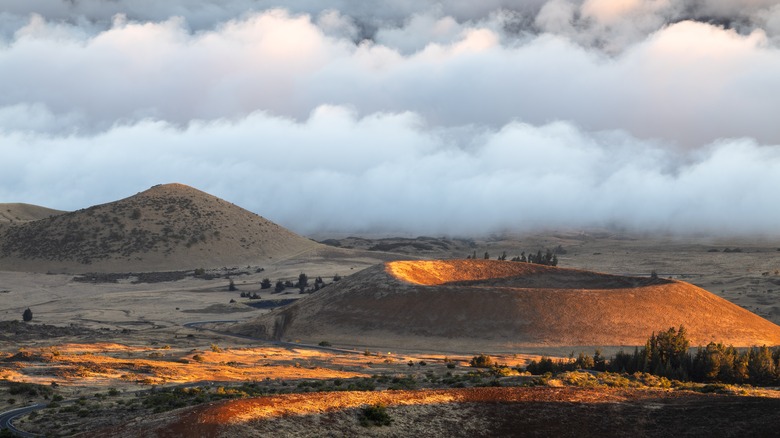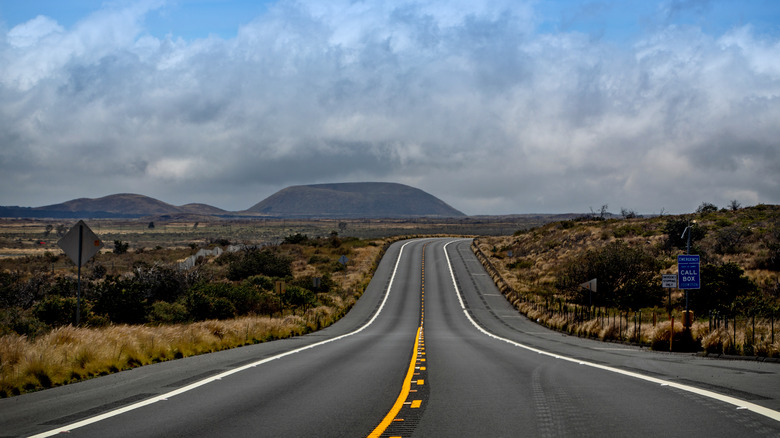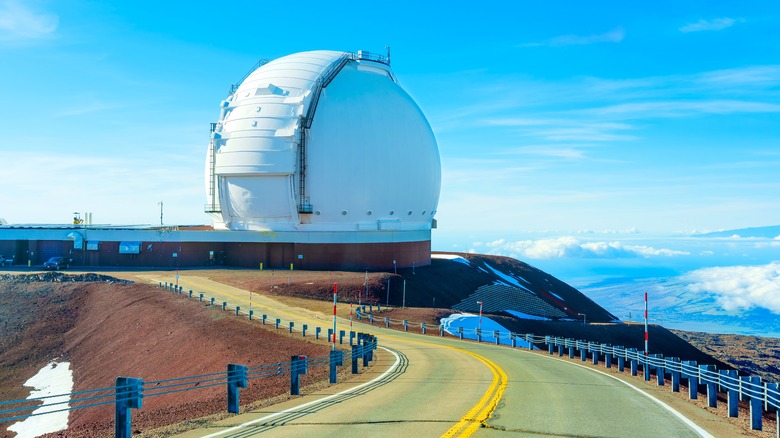This Iconic, Gorgeous Road Trip Route Is Considered One Of Hawaii's Most Dangerous
Originally built by the U.S. Army in 1942, remote Saddle Road crosses the Big Island of Hawaii, connecting Waimea in the west and Hilo, Hawaii's most underrated city, in the East. Until this century, it was a crumbling, one-lane road widely considered to be a dangerous disaster, so treacherous that rental car companies often forbade you to drive on it.
Picture volcanic landscapes so otherworldly that NASA uses them to simulate Mars, with weather patterns so unpredictable you need to carry emergency rations on what ought to be a 2-hour drive. It's now fully paved, with passing lanes, but that doesn't mean it's entirely safe. In a 2023 survey conducted by Gunther Mitsubishi, American drivers named it the 4th most feared road trip in the nation (via the Big Island Gazette).
The 50-plus mile road — also known as the Daniel K. Inouye Highway or Route 200 — was originally named for the high pass it crosses, the more than 6,600-foot Humu'ula Saddle that divides the twin volcanic peaks of Mauna Loa and Mauna Kea. Speaking of dangers, for example, when Mauna Loa erupted in 2022, lava flows came within 1.8 miles of Saddle Road, where throngs gathered to watch, resulting in at least one traffic fatality.
The dangers on Saddle Road are real
On top of avoiding the common reckless mistakes drivers make on road trips, you'll want to take extra precautions on Saddle Road. In good conditions, the entire traverse takes a couple of hours, but this island has fickle weather, so conditions are rarely good for long. You might be slowed by torrential downpours, pea soup fog, and everything in between — on the same day. Even when it's sunny, you'll want to drive slowly enough to brake for animals. "Be careful as this is a goat slalom course on many turns and with the rain they all run out to the road to try to drink fresh water," one Tripadvisor cautions. Another counted 18 animal carcasses in one drive, all roadkill. Watch out, too, for speed traps, as goats aren't the only ones lurking around the corner waiting to surprise you.
The top of Mauna Kea is dotted with international observatories, and to keep the sky pure for their benefit, Saddle Road has no lights. The inky blackness at night can be disorienting for drivers, so stay safe and make this a daytime trip. There are no stores or gas stations on the road, and a huge swath of the route is without cell service, so make sure your vehicle is good to go, and don't travel without water and emergency supplies. Just don't bring any cans of Spam, as local superstition holds that you'll have a break down if you carry pork products.
Saddle Road sights to see
You may be in lush Hawaii, but parts of this road, particularly where it transects the desolate, black, lava fields, have a decidedly desert-like aspect. One of the main attractions of Saddle Road is the variety of climate zones and landscapes you'll experience, from the lush jungle rainforest of Rainbow Falls, in the hidden gem that is Wailuku State Park near Hilo, to bleak lava fields near Mauna Kea. Take a quick side trip to Apollo Valley, which so resembles the moon that NASA uses it to test rovers.
You can drive almost to the top of Mauna Kea for a spectacular look across at massive Mauna Loa from the level of the observatories. Here you'll also find the trailhead to Lake Waiau, the highest body of water on the entire Pacific Rim. Conditions up here are alpine, so be prepared for the cold as well as the altitude, as the trailhead sits at 11,000 feet. If you start to feel ill, the only cure for altitude sickness is to go back down the mountain right away. Don't feel like climbing into nosebleed territory? For excellent views of the two big volcanoes, climb a smaller cinder cone that lies between them. The trail to the top of pretty little Pu'u Huluhulu is short and sweet, just a half-mile round trip for a perfect road-trip leg stretch.


